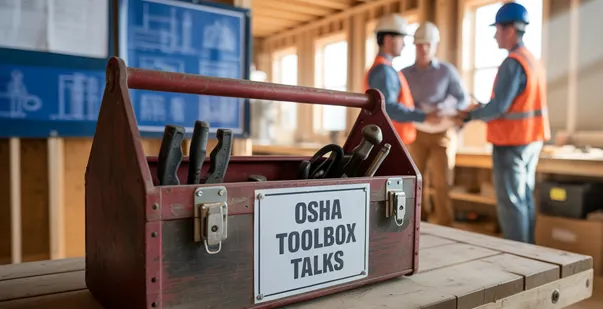Workplace injuries cost businesses over $167 billion each year in medical bills, lost productivity, and compensation claims. Unlike long training sessions, toolbox talks are quick, engaging, and relevant to daily tasks. OSHA Toolbox Talks are short, informal safety meetings designed to keep workers informed and safe on the job. Think of them as quick chats about important safety topics that help everyone stay on track and avoid accidents. These talks usually focus on one specific issue, like ladder safety, personal protective equipment, or how to handle hazardous materials.
These toolbox talks are a great way to make sure workers are up-to-date on the latest regulations and best practices in the workplace. Moreover, they fit easily into the workday and help build a stronger safety culture. So, keep reading to learn what exactly OSHA toolbox talks are, and how they make workplaces safer.
Read More: What is OSHA Training? All You Need to Know
Why Should Employers Conduct OSHA Toolbox Talks?
According to the Occupational Safety and Health Administration (OSHA), workplaces with regular safety meetings and toolbox talks experience up to 50% fewer workplace injuries. OSHA toolbox talks help prevent workplace accidents and injuries. These short safety meetings inform employees about potential hazards and teach them how to stay safe while working. Thus, there is a decrease in the risk of fines and legal issues for the company.
They also encourage open discussions, which allow workers to ask questions and share concerns. This builds a strong safety culture where everyone takes responsibility for preventing accidents. Fewer injuries mean lower costs, less downtime, and improved morale. Consistent toolbox talks show a company’s commitment to safety and employee well-being.
Important Topics For OSHA Toolbox Talks
Workplace safety is important for both employees and employers. OSHA toolbox talks cover many safety topics that help employees keep themselves safe, including:
Personal Protective Equipment (PPE)
Personal Protective Equipment (PPE) is the first line of defense against workplace hazards. It includes helmets to protect the head, gloves to shield hands, goggles for eye safety, and masks to prevent inhaling harmful substances. Workers should wear the right PPE for their tasks and inspect it for damage before use. Employers must ensure PPE fits properly and provide training on its correct usage to prevent workplace injuries.
Fall Prevention
Falls are one of the biggest causes of workplace injuries. Workers should always use fall protection equipment like harnesses, guardrails, and safety nets. Ladders and scaffolding must be inspected before use, and workers should follow the correct procedures when climbing. Slippery surfaces should be cleaned, and warning signs should be placed in hazardous areas. Preventing falls not only saves lives but also helps maintain a safer work environment.
Fire Safety
Fire hazards exist in almost every workplace, so employees must know how to prevent fires and respond to emergencies. Fire extinguishers should be placed in easily accessible locations, and workers must know how to use them. Emergency exits should be clear, and fire drills should be conducted regularly. Employers should also educate workers on common fire hazards, such as faulty electrical wiring and flammable materials.
Electrical Safety
Electrical hazards can cause serious injuries or even death. Workers should never use damaged electrical cords, and power tools must be checked before use. Keep water away from electrical sources to prevent shocks. Follow lockout/tagout procedures when working on electrical equipment to ensure it is safely shut down. Proper training in electrical safety can significantly reduce workplace accidents and injuries.
Hazard Communication
Employees must understand how to handle hazardous chemicals safely. Safety labels and warning signs should be clearly visible, and workers should know how to read them. Material Safety Data Sheets (MSDS) provide important details about handling, storage, and disposal of dangerous substances. Proper ventilation, protective equipment, and safe handling techniques are essential to prevent exposure to harmful chemicals in the workplace.
Machine Guarding
Machine guards are protective barriers that prevent workers from coming into direct contact with moving parts. Removing or tampering with these guards can lead to serious injuries, such as crushed hands or amputations. Workers should always check that machine guards are in place before operating equipment. Employers must ensure that machines are properly maintained and that employees receive training on the safe use of machinery.
Heat Stress and Hydration
Working in hot environments can lead to heat-related illnesses like heatstroke and dehydration. Employees should drink plenty of water, take breaks in shaded areas, and wear lightweight clothing. Employers should provide cooling stations and schedule demanding tasks during cooler parts of the day. Recognizing symptoms like dizziness, excessive sweating, and fatigue can help prevent serious health risks caused by extreme heat in the workplace.
Read More: What Is Hazard Communication Standard (HCS)?
How To Conduct OSHA Toolbox Talks?
OSHA toolbox talks are a great way to remind employees about important safety rules and how to prevent accidents. You can make sure everyone stays safe while working by keeping the discussion short and to the point. The steps to conduct such safety meetings are as follows:
Choose a Topic
Pick a safety topic that relates to the specific job site and tasks employees perform. Common topics include PPE, fire safety, fall prevention, and electrical hazards. Choosing a relevant topic ensures that employees understand the risks they face daily and how to protect themselves from accidents.
Prepare Your Key Points
List the most important safety takeaways. Keep the information clear, simple, and easy to remember. Avoid overwhelming employees with too much detail. Focus on essential facts that can help prevent injuries. Well-organized key points make the toolbox talk more effective and help employees apply the information in real-life situations.
Start with a Hook
Grab employees’ attention with an interesting question, a surprising statistic, or a real-life incident. For example, you could ask, “Did you know falls are the leading cause of workplace injuries?” A strong opening keeps workers engaged and makes them more likely to listen carefully to the safety message.
Discuss the Safety Issue
Explain the hazard, why it’s dangerous, and how to prevent accidents. Use simple language and avoid complex technical terms. Provide clear examples of unsafe behaviors and the consequences of ignoring safety rules. Helping workers understand the risks makes them more likely to follow proper safety practices.
Demonstrate If Possible
If the topic involves equipment or PPE, show employees how to use it correctly. Hands-on demonstrations help workers remember important details better than just listening. For example, if discussing fire extinguishers, show how to operate one properly to reinforce learning and ensure safety compliance.
Encourage Discussion
Allow employees to ask questions and share their own experiences. Discussions make the talk more engaging and help address real concerns. When workers actively participate, they understand the safety topic better and feel more responsible for keeping themselves and others safe.
Summarize Key Points
End the talk with a quick summary of the main takeaways. Reinforce the key safety rules and remind employees to follow them daily. A brief recap helps workers remember the most important information and apply it to their jobs, reducing the risk of workplace accidents.
Read More: How to Get OSHA Certified
Tips For Conducting OSHA Toolbox Talks
OSHA toolbox talks are a great way to reinforce workplace safety. However, to be effective, they must be well-structured and engaging. Here are some tips for conducting toolbox talks:
A toolbox talk should be brief but informative. Ideally, it should last between 5 and 15 minutes. Employees lose their attention during long meetings. Thus, employers should keep the discussion focused and emphasize only the most important safety points.
Select topics that relate to the specific job site and tasks employees perform. For example, construction workers may need regular talks on ladder safety and fall prevention, while factory workers should focus on machine guarding and electrical hazards.
Try to involve workers in the discussion by asking questions and encouraging them to share experiences. Employees who actively participate are more likely to remember safety information. Interactive talks also create a sense of teamwork and responsibility, making workplace safety a shared effort.
Share real workplace accidents and how they can be prevented to make safety talks more impactful. Real-life examples create a stronger connection and help workers take safety precautions more seriously.
Visual tools like posters, videos, or live demonstrations can make safety messages more memorable. For example, showing how to use a fire extinguisher or demonstrating proper lifting techniques is more effective than just explaining them.
Employers should keep a record of toolbox talks as it helps track safety improvements and ensures OSHA compliance. Each record should include the date, topic, and list of attendees. These documents will also be helpful in case of an OSHA inspection.
If an employee raises a safety concern during a toolbox talk, address it immediately. Ignoring concerns can make workers feel unheard and less likely to participate in future discussions. When employees see that their input leads to real safety improvements, they become more engaged and take workplace safety seriously.
Read More: What Are OSHA Handrail Requirements?
Create a Safer Workplace by Conducting OSHA Toolbox Talks!
OSHA toolbox talks are an important part of workplace safety. These short, focused meetings help employees stay aware of potential hazards and learn best practices to prevent accidents. By discussing important topics like PPE, fall prevention, fire safety, and electrical hazards, workers gain the knowledge they need to stay safe on the job. Employers must choose topics that fit their work environment, encourage participation, and use real-life examples to reinforce safety lessons. Keeping records of these talks also helps track progress and meet OSHA requirements.
If you want to improve workplace safety, consider OSHA training for your team. Enroll today to stay compliant and create a safer work environment for everyone.





